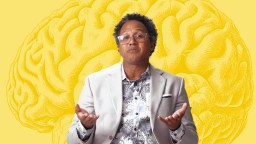Emotions are a powerful force. They’re so powerful, in fact, that sometimes it’s hard to look past our own feelings and see what others are experiencing.
To better understand this concept, we sat down with Kristen A. Lindquist, a professor of psychology and neuroscience at the University of North Carolina at Chapel Hill. “Powerful emotions feel like irrefutable facts,” she says. “They wash over us, take over our bodies and change our perceptions. We call this ‘affective realism,’ where your emotional experiences feel like they are the truth of the world around you, when in reality the culture we live in shapes your emotions…and your emotions serve as a lens for interpreting the world around you.”
Generally speaking, humans are born with the basic hardware that helps the brain create emotions and form physical responses to them – including tears when we’re sad, smiles when we’re happy and a pounding heartbeat when we’re afraid. But not all of the body’s responses are consistent from person to person.
“In the United States, which is a highly individualistic society, anger is about making yourself different from those around you,” Lindquist says. “It’s about showing that some sort of violation has occurred, setting a line in the sand and saying, ‘You did something wrong to me.’” She explains that these feelings lead to increased levels of stress and an increase in inflammation in the body, which can contribute to cardiovascular disease over time.
However, that same increase in inflammation is not seen in Japan as a response to anger. “In Japan, anger is a signal that harmony in the group has been disrupted and it’s a signal to mend bonds. A different physiological response to the same exact emotional experience,” she says.
Another key difference lies in how different cultures react to external factors and life experiences. Death is a significant one to analyze. For example, dying is most likely to be a solemn affair in European countries like England where it’s rarely discussed in detail and almost seen as taboo. Whereas in Mexico they have a very colorful national holiday (Día de los Muertos) to celebrate death, and they discuss it openly from a young age. Some research suggests that children growing up in a society that embraces death might be less fearful or anxious about death compared to those who have been shielded from it. Sadness is still experienced in these communities, but there is a positive outlook present because death is not viewed as such a finality.
And it’s not just how we experience our own emotions that differs in juxtaposing cultures. There have been studies into how we perceive emotions in others that offer surprising results. Lindquist references one such experiment in which test subjects were shown a series of randomized facial expressions on computer-generated faces and asked to identify which emotions they were seeing. Participants from China noticed a movement of an eyebrow or a wrinkling of the lip that Western subjects did not see. Likewise, subjects from the United Kingdom identified facial muscle movements associated with an emotion like anger that were not perceived to be associated with that emotion by those from China. In short, she explains that “we are imposing our own cultural biases onto people’s facial muscle movements.”
On the surface, this disconnect in emotional analysis and processing can seem disconcerting. How often are we misinterpreting social interactions – or being misunderstood, ourselves? But Lindquist recognizes it’s this diverse way of thinking that makes our world such a fascinating place to live.
“If you recognize that everybody’s psychology is a little bit distinct and that you are perhaps imposing your own bias onto things and have more of an open mind about trying to learn what somebody is feeling, instead of assuming, then there’s more avenues for connections across groups,” she says. “This diversity in perceptions could lead us to better answers about how it is that the world works. Understanding that people don’t have the same emotional mind as us could really open our eyes to how we are perceiving interactions in day-to-day life.”
We spoke to Kristen A. Lindquist for The Science of Perception Box, a Big Think interview series created in partnership with Unlikely Collaborators. As a creative non-profit organization, they’re on a mission to help people challenge their perceptions and expand their thinking. This series dives into the science behind our thought patterns. Watch Kristen A. Lindquist’s full interview above, and visit Perception Box to see more in this series.
Words: Jamie Carson
KRISTEN LINDQUIST: Powerful emotions feel like irrefutable facts. They wash over us, take over our bodies, and change our perceptions. We call this 'affective realism' where your emotional experiences feel like they are the truth of the world around you. When, in reality, the culture that we live in is, in a sense, shaping your emotions and your emotions are then serving as a lens for interpreting the world around you.
And the notion that people could be thinking and feeling something that is completely different from what we would think or feel in that context is frankly kind of scary. But understanding that people don't necessarily have the same emotional mind as us could really open our eyes to how it is that we're perceiving interactions in day-to-day life.
I'm Kristen Lindquist, and I'm a professor of psychology and neuroscience at the University of North Carolina at Chapel Hill- and I study the neural and cultural basis of emotion. Emotions are like cultural artifacts. They're things that are passed down over time from one individual to the next, like art and religion and the language that you speak. Now, I should clarify, this is not to say that there isn't a biological basis for those things. All humans are born with the basic hardware that helps the brain create emotions. Culture very much defines who we are, who we see ourselves as, who we want to be. And the experiences that you've had, which are very much nested in culture, can trickle down to the operation of single neurons that are processing visual sensations in the world around you.
One of the most prominent focuses of this work has been on cultures that are high in what's called individualism versus cultures that are high in what's called collectivism. As a case in point in the United States, which is a highly individualistic society, anger is about making yourself different from the people around you. It's about showing that some sort of violation has occurred, setting a line in the sand and saying, "You did something wrong to me." And when individuals in the United States experience anger, we see an increase in inflammation. Too much inflammation, too much stress ends up creating things like cardiovascular disease and many other disorders.
In Japan, anger does not show a robust increase in inflammation. In Japan, anger is a signal that harmony in the group has been disrupted and a signal to mend bonds. A different physiological response to the same exact emotional experience. But emotions like anger and sadness and fear seem so basic, so critical to our survival. And surely people from cultures around the world experience threats and experience their hearts beating quickly when their lives are in danger. That is not in question. The question is how it is that their brains are making meaning of those instances and experiencing them as something separate from other types of mental states.
In much of the early theorizing about emotion, it was assumed that facial muscle movements were automatically triggered, means of signaling somebody's internal state to other people. The theory has progressed on this over time to suggest that it may be that people are communicating what they feel with their facial expressions, but not automatically and reflexively, in much the same way that they would use language. There's some nice work that has been done using computer graphics to randomly display an avatar's face and randomly move its facial muscles.
Participants from China saw a movement of an eyebrow or a wrinkling of the lip that Western perceivers did not see. In the U.K., there were facial muscle movements associated with an emotion like anger that were not perceived to be associated with that emotion category in China. So there's a fair amount of variability in which specific facial muscle movements are associated with different categories. And what's really critical to understand is that the signals that people make with their face need not give some veritical representation of what it is that they're feeling. But secondly, that we are imposing our own cultural biases onto people's facial muscle movements.
This all comes down to something which in philosophy is called which is that we can never truly understand the content of other people's minds. And yet, when we encounter people from different cultures in daily life, even within our own cities, people who come from different regional backgrounds, or have different religious backgrounds, or even have different political identities- it can be stressful to encounter other cultures and realize that something is just a little bit out of sync. If you recognize that everybody's psychology is a little bit distinct and that you are perhaps imposing your own bias onto things and have more of an open mind about trying to learn what somebody is feeling instead of assuming, then there's more avenues for connections across groups.
Each person is bringing to bear really something that is unique, a unique angle on the world around them. And ultimately, this diversity in perceptions could lead us to better answers about how it is that the world works.




